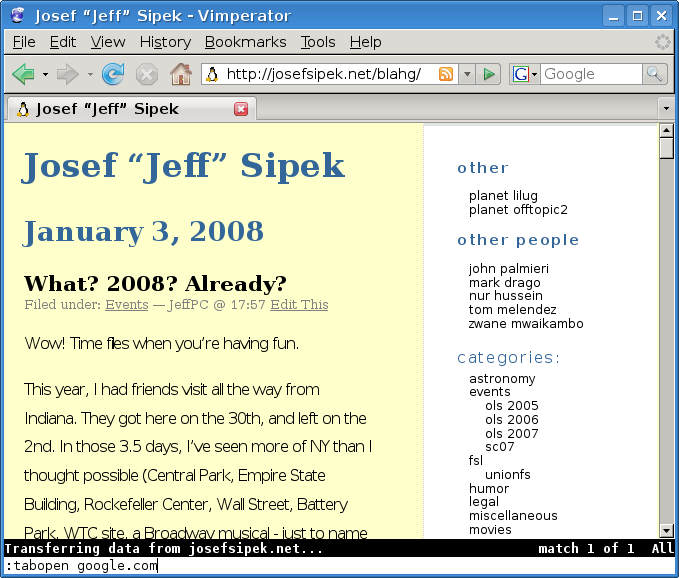Plotting G1000 EGT
It would seem that my two recent posts are getting noticed. On one of them, someone asked for the EGT R code I used.
After I get the CSV file of the SD card, I first clean it up. Currently, I just do it manually using Vim, but in the future I will probably script it. It turns out that Garmin decided to put a header of sorts at the beginning of each CSV. The header includes version and part numbers. I delete it. The next line appears to have units for each of the columns. I delete it as well. The remainder of the file is an almost normal CSV. I say almost normal, because there’s an inordinate number of spaces around the values and commas. I use the power of Vim to remove all the spaces in the whole file by using :%s/ //g. Then I save and quit.
Now that I have a pretty standard looking CSV, I let R do its thing.
> data <- read.csv("munged.csv")
> names(data)
[1] "LclDate" "LclTime" "UTCOfst" "AtvWpt" "Latitude" "Longitude"
[7] "AltB" "BaroA" "AltMSL" "OAT" "IAS" "GndSpd"
[13] "VSpd" "Pitch" "Roll" "LatAc" "NormAc" "HDG"
[19] "TRK" "volt1" "volt2" "amp1" "amp2" "FQtyL"
[25] "FQtyR" "E1FFlow" "E1OilT" "E1OilP" "E1RPM" "E1CHT1"
[31] "E1CHT2" "E1CHT3" "E1CHT4" "E1EGT1" "E1EGT2" "E1EGT3"
[37] "E1EGT4" "AltGPS" "TAS" "HSIS" "CRS" "NAV1"
[43] "NAV2" "COM1" "COM2" "HCDI" "VCDI" "WndSpd"
[49] "WndDr" "WptDst" "WptBrg" "MagVar" "AfcsOn" "RollM"
[55] "PitchM" "RollC" "PichC" "VSpdG" "GPSfix" "HAL"
[61] "VAL" "HPLwas" "HPLfd" "VPLwas"
As you can see, there are lots of columns. Before doing any plotting, I like to convert the LclDate, LclTime, and UTCOfst columns into a single Time column. I also get rid of the three individual columns.
> data$Time <- as.POSIXct(paste(data$LclDate, data$LclTime, data$UTCOfst)) > data$LclDate <- NULL > data$LclTime <- NULL > data$UTCOfst <- NULL
Now, let’s focus on the EGT values — E1EGT1 through E1EGT4. E1 refers to the first engine (the 172 has only one), I suspect that a G1000 on a twin would have E1 and E2 values. I use the ggplot2 R package to do my graphing. I could pick colors for each of the four EGT lines, but I’m way too lazy and the color selection would not look anywhere near as nice as it should. (Note, if you have only two values to plot, R will use a red-ish and a blue-ish/green-ish color for the lines. Not exactly the smartest selection if your audience may include someone color-blind.) So, instead I let R do the hard work for me. First, I make a new data.frame that contains the time and the EGT values.
> tmp <- data.frame(Time=data$Time, C1=data$E1EGT1, C2=data$E1EGT2,
C3=data$E1EGT3, C4=data$E1EGT4)
> head(tmp)
Time C1 C2 C3 C4
1 2013-06-01 14:24:54 1029.81 1016.49 1019.08 1098.67
2 2013-06-01 14:24:54 1029.81 1016.49 1019.08 1098.67
3 2013-06-01 14:24:55 1030.94 1017.57 1019.88 1095.38
4 2013-06-01 14:24:56 1031.92 1019.05 1022.81 1095.84
5 2013-06-01 14:24:57 1033.16 1020.23 1022.82 1092.38
6 2013-06-01 14:24:58 1034.54 1022.33 1023.72 1085.82
Then I use the reshape2 package to reorganize the data.
> library(reshape2)
> tmp <- melt(tmp, "Time", variable.name="Cylinder")
> head(tmp)
Time Cylinder value
1 2013-06-01 14:24:54 C1 1029.81
2 2013-06-01 14:24:54 C1 1029.81
3 2013-06-01 14:24:55 C1 1030.94
4 2013-06-01 14:24:56 C1 1031.92
5 2013-06-01 14:24:57 C1 1033.16
6 2013-06-01 14:24:58 C1 1034.54
The melt function takes a data.frame along with a name of a column (I specified “Time”), and reshapes the data.frame. For each row, in the original data.frame, it takes all the columns not specified (e.g., not Time), and produces a row for each with a variable name being the column name and the value being that column’s value in the original row. Here’s a small example:
> df <- data.frame(x=c(1,2,3),y=c(4,5,6),z=c(7,8,9)) > df x y z 1 1 4 7 2 2 5 8 3 3 6 9 > melt(df, "x") x variable value 1 1 y 4 2 2 y 5 3 3 y 6 4 1 z 7 5 2 z 8 6 3 z 9
As you can see, the x values got duplicated since there were two other columns. Anyway, the one difference in my call to melt is the variable.name argument. I don’t want my variable name column to be called “variable” — I want it to be called “Cylinder.”
At this point, the data is ready to be plotted.
> library(ggplot2)
> p <- ggplot(tmp)
> p <- p + ggtitle("Exhaust Gas Temperature")
> p <- p + ylab(expression(Temperature~(degree*F)))
> p <- p + geom_line(aes(x=Time, y=value, color=Cylinder))
> print(p)
That’s all there is to it! There may be a better way to do it, but this works for me. I use the same approach to plot the different altitude numbers, the speeds (TAS, IAS, GS), CHT, and fuel quantity.
You can download an R script with the above code here.

